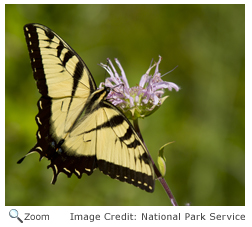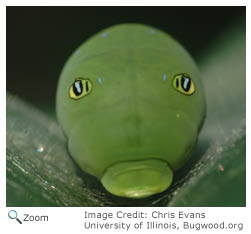Characteristics
 The color of the eastern tiger swallowtail can vary. Males are yellow or yellow-orange with black tiger stripes. Their wings are bordered in black with yellow spots, and there are black "tiger stripes" running across the top of their wings. Their long black tails have blue patches on them. The color of the eastern tiger swallowtail can vary. Males are yellow or yellow-orange with black tiger stripes. Their wings are bordered in black with yellow spots, and there are black "tiger stripes" running across the top of their wings. Their long black tails have blue patches on them.
 Females can range in color from the yellow of the male to an almost solid bluish-black. The black form the the eastern tiger swallowtail is most common in the southern part of its range in areas also inhabited by the pipevine swallowtail, a butterfly that has an unpleasant taste. The black form of the eastern tiger swallow tail may be an example of deceptive coloration using mimicry. Females can range in color from the yellow of the male to an almost solid bluish-black. The black form the the eastern tiger swallowtail is most common in the southern part of its range in areas also inhabited by the pipevine swallowtail, a butterfly that has an unpleasant taste. The black form of the eastern tiger swallow tail may be an example of deceptive coloration using mimicry.
Range
 The eastern tiger swallowtail is found in North America east of the Rocky Mountains from Ontario south to the Gulf coast and northern Mexico. It flies from the spring through the fall. The eastern tiger swallowtail butterfly is found in New Hampshire. The eastern tiger swallowtail is found in North America east of the Rocky Mountains from Ontario south to the Gulf coast and northern Mexico. It flies from the spring through the fall. The eastern tiger swallowtail butterfly is found in New Hampshire.
Habitat
The eastern tiger swallowtail lives in deciduous woods along streams, rivers and swamps.
|
|
Food
 Eastern tiger swallowtail larvae eat the leaves of a variety of woody plants including wild cherry, tulip, birch, ash, cottonwood, and willow. Adults eat the nectar of flowers from a variety of plants including butterfly bush, milkweed, Japanese honeysuckle, phlox, lilac, ironweed, and wild cherry. Eastern tiger swallowtail larvae eat the leaves of a variety of woody plants including wild cherry, tulip, birch, ash, cottonwood, and willow. Adults eat the nectar of flowers from a variety of plants including butterfly bush, milkweed, Japanese honeysuckle, phlox, lilac, ironweed, and wild cherry.
Life Cycle
 Female eastern tiger swallowtail butterflies lay single green eggs on the leaves of woody plants. The caterpillar is brown and white when it is young, but it changes as it grows older. Female eastern tiger swallowtail butterflies lay single green eggs on the leaves of woody plants. The caterpillar is brown and white when it is young, but it changes as it grows older.
When the eastern tiger swallowtail caterpillar matures it is green with orange and black false eyespots. The eye spots are a type of deceptive coloration that helps protect the caterpillar from predators. Predators see the eye spots and think that the caterpillar is a much large animal than it really is!
Behavior
Eastern tiger swallowtails are loners. Males will fly from place to place looking for a mate.
|